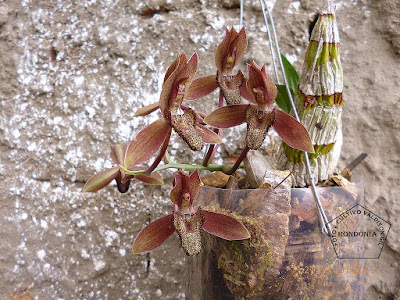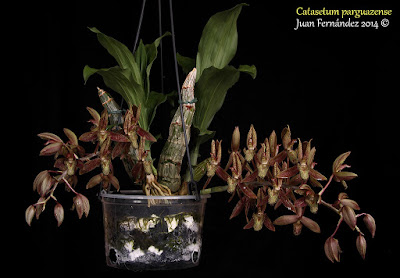Catasetum parguazense is found in Southeastern Venezuela (Bolívar State, near the Parguaza, Carrao, and Churún Rivers) and northwestern Brazil (states of Amazonas, Rondônia, and Pará). It grows on trees along rivers in wet forests at elevations of 50 to 1000 meters.
Catasetum parguazense also called as The Parguaza River Catasetum, is a species of the genus Catasetum. This species was described by Gustavo Adolfo Romero & Germán Carnevali in 1989.
IDENTIFY CATASETUM PARGUAZENSE ORCHID PLANT
Catasetum parguazense is found in Southeastern Venezuela (Bolívar State, near the Parguaza, Carrao, and Churún Rivers) and northwestern Brazil (states of Amazonas, Rondônia, and Pará). It grows on trees along rivers in wet forests at elevations of 50 to 1000 meters.
It is a small sized, hot to warm growing epiphyte with fusiform, 6 cm long and 1.5 cm wide (somewhat larger in adults) pseudobulbs carrying, dark green, oblanceolate, plicate, to 8 cm long and 2.5 cm wide leaves.
The Parguaza River Catasetum blooms in the spring and summer with a basal, slightly arching then pendant, 7.5 cm long, 2 to 8 flowered inflorescence arising on a newly emerging pseudobulb carrying resupinate flowers. The male flowers are 40 x 42 mm in their natural position with coloration of peduncle green; pedicels red-brown; sepals and petals green with red-brown spots; spotting on the lateral sepals heavier but the color less vivid; same coloration on the lip but darker, especially the bristles on the margins; column pearly white, with the same spotting, but minute. The female flowers are not seen.
This species is distinguished from other members of the Catasetum callosum alliance by its roughly heart-shaped, trilobed lip. Distinguished from Catasetum poriferum by its long antennae and erect-patent lateral lobes of the lip. Flowers from a developing new growth, and only then.
CATASETUM PARGUAZENSE ORCHID PLANT CARE AND CULTURE
Cultural information should only be used as a guide, and should be to be adapted to suit you. Your physical location; where you grow your plants, how much time you have to devote to their care, and many other factors, will need to be taken into account. Only then can you decide on the cultural methods that best suit you and your plants.
Light:
Catasetum parguazense are sun-loving plant and needs a light level of 30000-60000 lux. Unless the strong air movement found in the natural habitat can be duplicated, however, the grower should provide some shade (40-60 % shade). This species can be grown under lights if sufficient light intensity can be provided, and the plant certainly can be summered outdoors if their moisture requirements can be met.
Temperature:
Even in their natural habitat the dry season lasts roughly half the year, the nighttime temperatures should not fall below 18°C, with daytime highs generally from 29 to 35°C. The important thing is to maintain evenly warm conditions, and for this orchid the closer the night minimum is to 21°C, the better the plants will respond.
Humidity:
The Parguaza River Catasetum tolerate an environment with 40 - 60 % relative humidity during their growing season, but for optimal development of new growth and flowering, 70 % is recommended.
Substrate, growing media and repotting:
Catasetum parguazense should be grown in a net pot filled with loosely packed sphagnum. It is recommended to repot every year and never wait more than two years. The optimal time for potting or repotting is when new growth on a plant emerging from dormancy is about 5 cm tall and the nubs have developed into new roots that are reaching for support.
Watering:
In its natural habitat it receives rainfall frequently even while dormant. The plant may be watered every sunny day during the growing season, provided conditions are such that they dry off relatively quickly. This species like to dry out at least slightly between waterings.
Fertilizer:
Fertilize with an appropriate formulation at least every week during the growing season, or fertilize with a weak formula every time the plants are watered. It is important to begin regular applications of high-nitrogen fertilizer (such as 10-5-5) with a full range of trace elements. As the leaves begin to unfurl, and well before flowering, add a high-phosphorus formula to develop big, strong pseudobulbs capable of producing robust inflorescences. Any of the soluble products with a large second-digit number (for example, 3-12-6) constitute a good source of phosphorus.
Rest period:
At least some of Catasetum parguazense basic root system will survive from one growing season to the next increases. For this reason it is desirable to maintain a watering schedule, albeit reduced, during dormancy.















COMMENTS